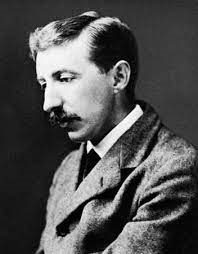E.M. Forster
On my trip in March to Costa Rica for dental implants, I found a book, E.M. Forster’s A Room With a View, left in a drawer where I
lodged, and began reading. It was tattered, the back cover almost severed, and I took it home to finish it. Okay, so I’m a thief.
While the book might fit into the romance genre, it is by no means inane or sappy – which is not to imply that all romance novels deserve that characterization. In fact, I am sentimental enough to have enjoyed The Bridges of Madison County, panned by many, though not all, critics as, yes, sappy. (Maybe it has something to do with my having grown up in the vicinity of the Roseman Bridge near Des Moines, setting for the book and the movie with Clint Eastwood and Meryl Streep, which I thought was even better than the novella, one of the 20th century’s best-selling books.
Forster’s book does not have that emotional appeal; it’s set in prim and proper England – as well as Italy – at the end of the Victorian era, early in the 20th century, after all, but I nonetheless found it captivating, if a bit cryptic in places. The abundant dialogue by a variety of characters is so perfect as to seem unreal – until one realizes that assessment is based on the standards of today’s broken vernacular. In lesser hands, the characters would be dull, but Forster breathes life into them.
In 1985, the book was made into a multi-award-winning movie starring relatively unknown actors along with a bevy of famous names.

Madison County, Iowa, covered bridge
Forster, best known for the 1924 A Passage to India, seems to be bidding the stodgy era, which ended four years before A Room’s publication, a not-so-fond farewell. The storyline has no patience for the disdainful pedantry represented in the character of Cecil Vyse, the intended groom of Lucy Honeychurch. Therein lies the plot. Will Mr. Vyse and Lucy end up tying the knot, or will the impetuous George Emerson overcome society’s false standards and win her over. The outcome is not as foreordained as one might expect in a romance novel. It doesn’t leave nearly the impact of The Bridges’ ending, but is satisfying nonetheless.
The book explains the gender attitudes of the day, and Forster, a revered social and literary critic as well as novelist, subtly condemns them. “Why were most big things unladylike? Charlotte had once explained to her why. It was not that ladies were inferior to men; it was that they were different. Their mission was to inspire others to achievement rather than to achieve themselves. Indirectly, by means of tact and a spotless name, a lady could accomplish much. But if she rushed into the fray herself she would be first censured, then despised, and finally ignored.” Well over a century later, A Room With a View presents views serving as penetrating insights into timeless human behavior – and all without bloodshed or explosive drama — or sappiness.

